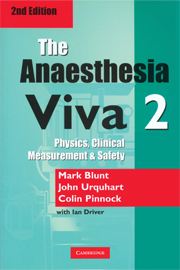Book contents
- Frontmatter
- Foreword to the First Edition
- Preface to the Second Editions
- Contents
- Physics, Clinical Measurement & Safety
- Clinical Anaesthesia
- Example 1
- Example 2
- 6 Example 3
- 7 Example 4
- Example 5
- Example 6
- Example 7
- Example 8
- Example 9
- Example 10
- Example 11
- Example 12
- Example 13
- Example 14
- Appendix 1
- Appendix 2
- Index
Example 1
Published online by Cambridge University Press: 05 February 2015
- Frontmatter
- Foreword to the First Edition
- Preface to the Second Editions
- Contents
- Physics, Clinical Measurement & Safety
- Clinical Anaesthesia
- Example 1
- Example 2
- 6 Example 3
- 7 Example 4
- Example 5
- Example 6
- Example 7
- Example 8
- Example 9
- Example 10
- Example 11
- Example 12
- Example 13
- Example 14
- Appendix 1
- Appendix 2
- Index
Summary
Scenario
A 54-year-old man presents for the repair of an inguinal hernia under GA as a day case. He is a smoker and admits to occasional chest pain on exercise for which his GP has prescribed a GTN spray. His ECG is normal apart from occasional unifocal ventricular ectopics and he is normotensive.
Discussion will follow from the presentation of the scenario and will be directed by the examiner.
You will be asked to consider the technique you would use, whether the ECG findings are important and the significance of ischaemic heart disease with respect to the conduct of anaesthesia. Usual day case criteria must be applied – ask about other features in the history (e.g. angina at rest? crescendo pattern? which would make the procedure undesirable). In the absence of any other factors, choose a cautious GA technique – propofol, opioid and volatile with a field block. Watch monitors for adverse events and avoid hypotension. In reality, there will be patients such as this served up every day across the country and basic principles of good anaesthetic practice apply (e.g. preoxygenation). This scenario often leads into a critical arrhythmia on table.
CRITICAL INCIDENT – ARRHYTHMIA
You notice occasional ventricular extra systoles which rapidly progress to 1 in 4 beats.
- Type
- Chapter
- Information
- The Anaesthesia Viva , pp. 83 - 85Publisher: Cambridge University PressPrint publication year: 2003

